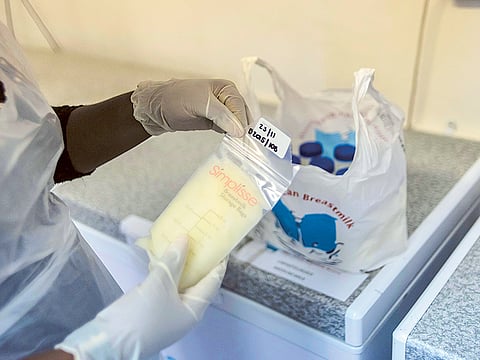Uranium in breastmilk raises alarm in Bihar, but experts say immediate risk low
Groundwater contamination suspected; experts call for wider testing

Dubai: A comprehensive multi-institutional study has detected uranium (U-238) in the breastmilk of lactating mothers across several districts of Bihar, raising concerns about long-term exposure among infants.
While the levels found remain below global safety thresholds, health experts warn that the contamination of groundwater and the food chain demands urgent investigation.
The study, conducted by Mahavir Cancer Sansthan (Patna), Lovely Professional University (Punjab), AIIMS Delhi and supported by ICMR and NIPER-Hajipur, analysed breastmilk from 40 randomly selected lactating women. Uranium was detected in all 40 samples, with concentrations ranging from 0 to 5.25 µg/L. The highest individual reading came from Katihar district.
How uranium can harm the body
Uranium is a heavy metal that can accumulate in the kidneys, making infants especially vulnerable because their kidneys are still developing.
Prolonged exposure may interfere with neurological development, potentially affecting memory, behaviour and cognitive functions.
Long-term ingestion can contribute to lowered IQ scores, learning delays and slower neurodevelopment if concentrations remain high over years.
Uranium exposure may alter bone metabolism and affect overall growth because infants’ bodies absorb minerals more rapidly.
Although uranium is weakly radioactive, the primary risk comes from its chemical toxicity, not radiation, meaning the damage is more metabolic than radiological.
Adults typically excrete most of the uranium they ingest, but infants cannot eliminate it as efficiently, increasing their susceptibility.
Current levels detected in Bihar breastmilk remain below global safety thresholds, which means actual harm is considered unlikely, but ongoing monitoring is essential.
Co-author Dr Ashok Sharma of AIIMS Delhi told ANI that although 70% of infants showed potential non-carcinogenic risk based on risk-modelling indicators, the actual health impact is expected to be low because uranium does not concentrate significantly in breastmilk. “Most uranium absorbed by the mother is excreted through urine, not transferred to the child,” he said, adding that breastfeeding should continue unless medically advised otherwise.
Groundwater: Likely source of contamination
The same research team examined groundwater samples across Bihar and found significant uranium contamination in multiple districts.
The highest groundwater uranium levels were reported in: Supaul: 82 µg/L; Nalanda: 77 µg/L and Vaishali: 66 µg/L
These levels exceed the WHO’s recommended limit of 30 µg/L, pointing to a deeper environmental challenge.
According to the study, uranium may be entering the food chain through contaminated drinking water and irrigation sources. Groundwater over-extraction, untreated industrial effluents, and the extensive use of pesticides and chemical fertilisers are believed to be worsening the contamination.
“Groundwater and soil pollution over time have allowed heavy metals to seep into the environment and eventually into food,” the report states. Researchers note that pollutants can migrate from soil to crops, then to mothers, and ultimately appear in breastmilk.
Health concerns and long-term risks
Experts caution that while the detected breastmilk levels do not pose an immediate threat, long-term exposure could affect infant health. Uranium is known to impact: Kidney development, Neurological growth, Cognitive functions (including IQ and learning ability) and cancer risk over prolonged periods
Dr Ashok Sharma told Times of India that uranium infiltrating the food chain is “a very serious concern”, even if present levels are not yet harmful. Infants are particularly vulnerable due to their limited capacity to eliminate heavy metals.
The study explains that uranium’s chemical toxicity — not its radiation — poses the primary danger. However, the element has low affinity for breastmilk components like fats and proteins, reducing direct transfer to infants. It tends to accumulate instead in maternal bones and kidneys, binding to phosphate and carbonate compounds.
Experts offer reassurance — with a warning
In a separate statement, nuclear scientist Dr Dinesh K Aswal, NDMA member and former BARC group director, said the findings are no cause for panic. “The levels detected are well within safe limits. WHO’s permissible threshold in drinking water is nearly six times higher than what was found,” he said.
Despite the reassurance, scientists agree the study is a warning sign that demands stronger environmental monitoring. Uranium contamination has already been reported in 151 districts across 18 Indian states.
Globally, similar contamination has been reported in regions of the US, Canada, Finland, Sweden, Switzerland, Pakistan, Bangladesh, China and the lower Mekong basin — though clear clinical symptoms have not been consistently observed.
Next steps: Statewide and national monitoring needed
The research team says Bihar now requires extensive testing of groundwater, soil, crops and breastmilk. The Geological Survey of India (GSI) is already investigating possible geogenic sources.
“Further biomonitoring of toxic contaminants — including pesticides, arsenic, lead and mercury — is essential to protect mothers and infants,” Dr Sharma said.
Sign up for the Daily Briefing
Get the latest news and updates straight to your inbox


